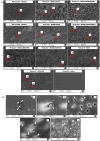A matched irrigation and obturation strategy for root canal therapy
- PMID: 33633128
- PMCID: PMC7907354
- DOI: 10.1038/s41598-021-83849-y
A matched irrigation and obturation strategy for root canal therapy
Abstract
In root canal therapy, irrigating solutions are employed to eliminate the bacterial load and also prepare dentin for sealer interaction. The aim of this research was to assess how irrigating solutions employed on their own or in sequence affected the tooth structure. The best way to prepare the tooth for obturation using hydraulic calcium silicate cement (HCSC) sealers and gutta-percha, thus guiding clinicians on a matched irrigation-obturation strategy for optimized root canal treatment was investigated. The effect of irrigating solutions on dentine was investigated by assessing changes in dentin microhardness, ultrastructure and mineral content, organic/inorganic matter, surface roughness and Young's modulus. The interaction of four root canal sealers with the dentin was analysed by assessing the changes in microhardness of the dentin after sealer placement and also the sealer to dentin interface by scanning electron and confocal laser microscopy. The irrigating solutions damaged the dentin irreversibly both when used on their own and in combination. The best sequence involved sodium hypochlorite followed by chelator and a final rinse with sodium hypochlorite and obturation using HCSC sealers that enabled the restoration of dentin properties. The HCSC sealers did not rely on chelator irrigating solutions for a good material adaptation to dentin.
Conflict of interest statement
The authors declare no competing interests.
Figures




Similar articles
-
Retreatment efficacy of hydraulic calcium silicate sealers used in single cone obturation.J Dent. 2020 Jul;98:103370. doi: 10.1016/j.jdent.2020.103370. Epub 2020 May 7. J Dent. 2020. PMID: 32387505
-
Interface of dentine to root canal sealers.J Dent. 2014 Mar;42(3):336-50. doi: 10.1016/j.jdent.2013.11.013. Epub 2013 Nov 25. J Dent. 2014. PMID: 24287256
-
Wettability of root canal sealers on intraradicular dentine treated with different irrigating solutions.J Dent. 2013 Jun;41(6):556-60. doi: 10.1016/j.jdent.2013.04.005. Epub 2013 Apr 16. J Dent. 2013. PMID: 23603234 Clinical Trial.
-
Effect of Different Irrigating Solutions on Root Canal Dentin Microhardness-A Systematic Review with Meta-Analysis.J Funct Biomater. 2024 May 16;15(5):132. doi: 10.3390/jfb15050132. J Funct Biomater. 2024. PMID: 38786643 Free PMC article. Review.
-
Novel Bioactive and Therapeutic Root Canal Sealers with Antibacterial and Remineralization Properties.Materials (Basel). 2020 Mar 1;13(5):1096. doi: 10.3390/ma13051096. Materials (Basel). 2020. PMID: 32121595 Free PMC article. Review.
Cited by
-
Advances in the Role of Sodium Hypochlorite Irrigant in Chemical Preparation of Root Canal Treatment.Biomed Res Int. 2023 Jan 13;2023:8858283. doi: 10.1155/2023/8858283. eCollection 2023. Biomed Res Int. 2023. PMID: 36685672 Free PMC article. Review.
-
Herbal Agents versus Ethylene Diamine Tetra Acetic Acid on Removal of the Smear Layer-A Systematic Review of In Vitro Studies.Int J Environ Res Public Health. 2022 Jun 3;19(11):6870. doi: 10.3390/ijerph19116870. Int J Environ Res Public Health. 2022. PMID: 35682452 Free PMC article.
-
The Effect of Irrigation Solutions on the Setting Time, Solubility, and pH of Three Types of Premixed Bioceramic-Based Root Canal Sealers.Int J Dent. 2025 Aug 19;2025:1995662. doi: 10.1155/ijod/1995662. eCollection 2025. Int J Dent. 2025. PMID: 40880978 Free PMC article.
-
Effect of herbal irrigants on surface roughness of intraradicular dentin using quantitative method of 3D surface texture analysis.Sci Rep. 2024 Jul 4;14(1):15439. doi: 10.1038/s41598-024-65245-4. Sci Rep. 2024. PMID: 38965301 Free PMC article.
-
Successful root canal therapy during COVID-19 pandemic.J Dent Sci. 2022 Apr;17(2):1079-1080. doi: 10.1016/j.jds.2022.02.010. Epub 2022 Feb 21. J Dent Sci. 2022. PMID: 35222838 Free PMC article. No abstract available.
References
Publication types
MeSH terms
LinkOut - more resources
Full Text Sources
Other Literature Sources

